E Color Grade Diamonds
What are E color diamonds and are they a good choice for an engagement ring?
We are reader-supported. Buying through any red colored link on our site may earn us commissions. Learn More.
What are E color diamonds and are they a good choice for an engagement ring?
E color diamonds are a top-tier choice, offering a near-perfect, colorless appearance. They’re a step away from the highest grade, D, but to the naked eye, the difference is negligible. The GIA grades diamonds in the D, E, and F range as “colorless”. However, this high quality comes at a cost. For instance, a 1-carat E color diamond can start from around $6,500. But remember, diamonds with slightly lower color grades, such as G or H, can still look stunning and cost significantly less, starting from around $5,000. Your choice should align with your personal preference and budget.
Here’s what we’ll cover in this article:
What are E color diamonds?
How do E color diamonds compare to other colors?
What setting is best for an E color diamond?
What do E color diamonds cost?
Where to buy E color diamonds
Why you should trust us
As we covered in our guide to diamond color grades, all diamonds receive a grade between D and Z which denotes their color. As GIA, the worlds leading diamond certification laboratory, puts it: “A chemically pure and structurally perfect diamond has no hue, like a drop of pure water, and consequently, a higher value. GIA’s D-to-Z diamond color grading system measures the degree of colorlessness by comparing a stone under controlled lighting and precise viewing conditions to masterstones of established color value.”
S through Z, on the other hand, are the lowest grades and are typically used for diamonds that display an obvious, clearly visible yellow or brown tint.
As the second highest color grade, E color diamonds are considered colorless. While they may not have quite as strong an icy, transparent appearance as D color diamonds, they appear fully colorless when viewed with the naked eye and under bright lighting and magnification.
The difference between a D color diamond and an E color diamond is very subtle, with only an expert gemologist with advanced laboratory equipment able to tell the difference. To the naked eye, there’s no visible difference between one diamond’s color and that of the other.
There’s also no visible difference in color, at least to the naked eye, between an E color stone and an F color one. However, in some cases, it is possible to see the color difference between an E color diamond and a stone in a lower color grade, such as H, I or J.

From a color perspective, E color diamonds look fantastic. Their colorless appearance means they look particularly impressive in white metals like white gold and platinum, which show the color of a diamond more clearly than yellow or white gold.
However, this doesn’t necessarily mean that choosing an E color diamond is always the best decision. As we’ve shown below, the difference in color between an E color diamond and one with a lower color grade can be very small, while the difference in price can be immense.
Are you thinking of buying an E color diamond for your fiancé-to-be’s engagement ring or other diamond jewelry? Does a diamond like this from Blue Nile seem like an absolutely perfect choice for you? Can you tell the difference between that one and this one from Blue Nile which is almost $4,500 cheaper?
In most cases (the exception being fancy colored diamonds), being completely colorless is a desirable trait to have from a diamond. That’s why the GIA, and other grading entities, grade diamonds on the amount of color present, and why diamonds with a high grade in color are significantly more expensive.
Diamond grading entities view diamonds under special conditions, such as controlled lighting, to establish the level of color present. Those on the high end of the scale exhibit no noticeable tint or hue, even under intense magnification or precise viewing conditions.
As a consumer, your goal when assessing diamond color should be to find a diamond that appears colorless under normal viewing conditions. An H color diamond, for example, may have a very faint yellow tint when viewed by a professional in a lab. But to the naked eye, it will almost always appear beautiful and devoid of any color.
As mentioned earlier, diamond color grades range from D, the highest, to Z, the lowest.
In accordance with the GIA’s grading for diamond color, D to F diamonds are colorless and G to J diamonds are near colorless. Below this, diamonds can be expected to show a noticeable, if slight, yellow or brown hue.
See the infographic below for a visual depiction of the diamond color scale:
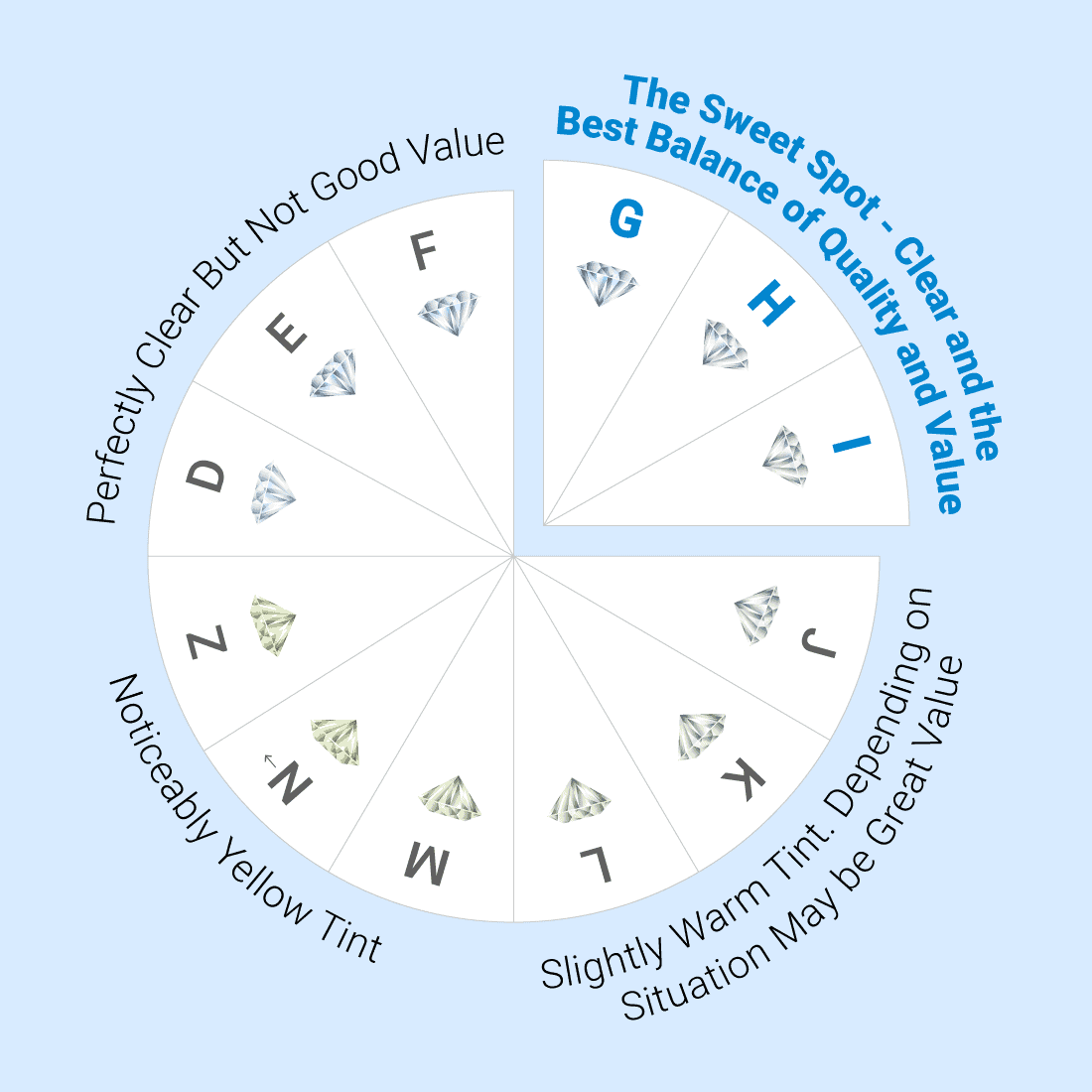
If you’ve previously read our full guide to diamond color, you’ll probably be aware that we don’t recommend overpaying for a diamond with an unnecessarily high color grade.
Instead, the most effective approach from a value for money perspective is to pick a diamond that looks white in relation to its setting. This can often be achieved by choosing a color grade that’s well below the colorless range.
We’ve shared some comparisons a little further down the page to highlight this point. For now, let’s start by looking at the differences — or lack of differences — between an E color diamond and a D color diamond.
The difference between an E color diamond and a D color diamond is extremely slight, so much so that there is essentially no way to tell one from the other – especially for the naked eye.
For example, look at the two round diamonds below. On the left, we have this 0.80 carat, VS2 clarity, excellent cut, E color round brilliant cut diamond from James Allen. On the right, we have this diamond from James Allen of the same cut, clarity and carat weight, but with a D color grade:
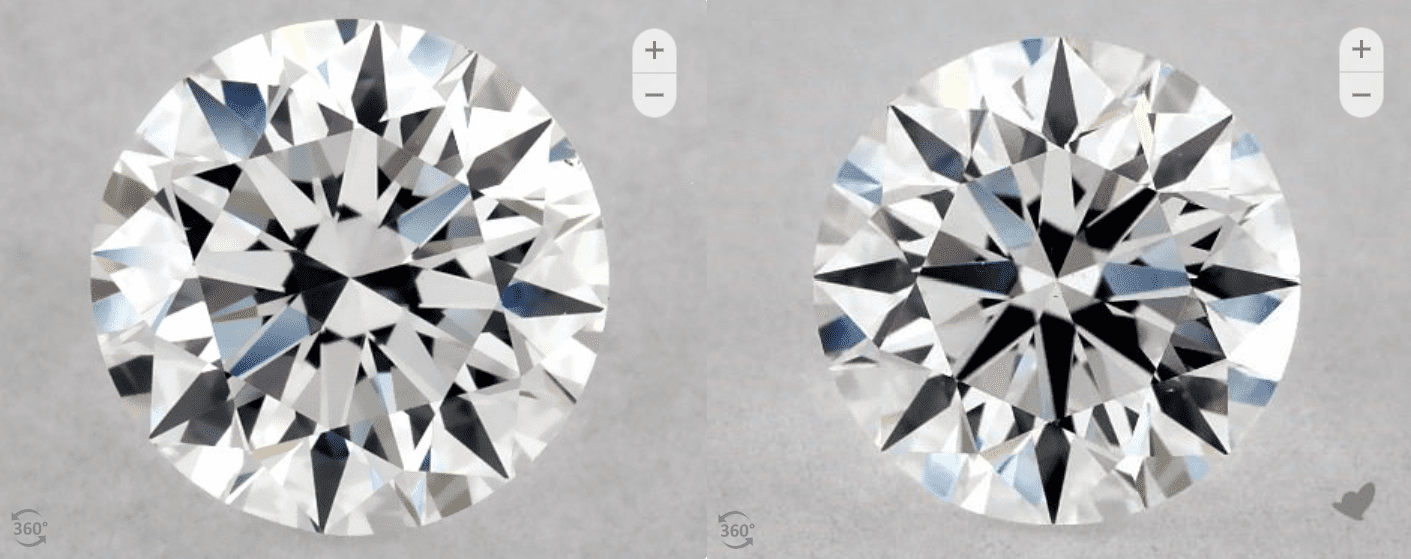
Can you see any difference in color between these two diamonds? Even under bright lighting and strong magnification, it’s virtually impossible to see any difference in color between these two diamonds, despite one receiving an E color grade and the other a D color grade.
Despite this, there’s a small difference in price, with the D color stone (on the right) priced at $4,670 and the E color diamond (on the left) available for $4,500, or almost 4% less.
Even when the diamonds are viewed close up in bright lighting, this $170 difference in pricing translates into no visible difference in the appearance of the two diamonds.
The visible difference between an E color diamond and an F color diamond is again extremely slight. Both E and F color diamonds are considered colorless on the GIA’s diamond grading scale, which means they lack any noticeable color, even under magnification and precise viewing conditions.
If we compare the E color diamond above to this one with an F color grade, the appearance is virtually identical. In a lab, it may be possible to pick out a very faint increase in color present in the F color diamond, but to the naked eye, distinguishing them would be impossible.
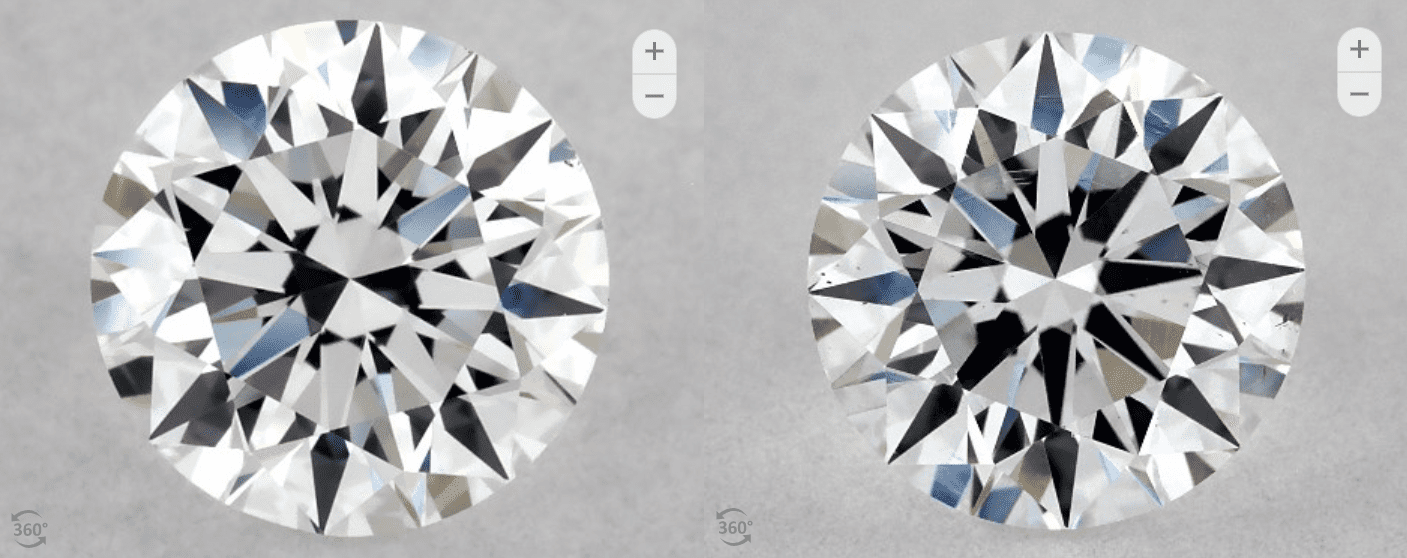
Similarly to the comparison above, there is a difference of nearly $260 which, while not a massive amount, is still extra money spent for zero difference to the naked eye.
Now, let’s do the same comparison with an E color diamond and a G color diamond. Below, we’ve compared the same E color round diamond (left) to this G color diamond from James Allen of the same clarity, carat weight and cut (right):

Ignoring any issues caused by the different angles of the photographs, can you see any real difference in color between these diamonds? Even close up and with bright light, there isn’t a clear difference in color when the diamonds are viewed from above.
Even from the side, the difference in color is extremely small — so small that you could never see it with the naked eye:

Remember, the images above are magnified to 20 times their normal size and lit very brightly to make any imperfections in the diamonds obvious. In real life, the two diamonds pictured above look virtually identical to the naked eye.
Just like there isn’t much of a perceptible difference between a D color diamond and an E color one, there also isn’t much of a difference between an E color diamond and a diamond with a G, or even H, color grade.
Despite this, there’s quite a significant difference in price between E color diamonds and those in lower color grades.
Using our same example of the E color diamond above, this H color diamond from James Allen costs $3,290 – a $1,210 difference.
Even more pronounced is this I color diamond, which is $1,560 less than the E color diamond.
At this range, it is much easier to tell the difference with an E color diamond, if you were to examine two diamonds side-by-side. However, an H or I color diamond should still appear colorless if you were to view it on its own, set in a ring.
Generally speaking, it’s important to take the ring setting into account when deciding on a color grade. That’s because the color of the setting can have a large impact on the perceived level of color present in the diamond as well.
For example, with a light colored setting, like white gold or platinum, a yellow tint in the diamond will be easier to spot. But a yellow gold ring, on the other hand, does a good job of masking diamond color and allows you to go lower in color grade (as low as K color), with the diamond still appearing colorless.
If you’re buying an E color diamond, however, there are zero concessions necessary in terms of ring settings. An E color diamond will appear colorless in any setting style or metal type.
As we mentioned above, E color diamonds are slightly less expensive than D color diamonds, with the D and E color diamonds we used for our visual comparison differing in price by only about three percent.
However, as you start going further down the color scale from the E and F range, the cost of diamonds begins to drop quite quickly.
For example, the G color diamond we featured above is $4,010 — a full $490, or 10%, cheaper than the equivalent E color diamond.
The I color diamond from James Allen that we mentioned above, which is certainly colorless enough to look great in a white gold or platinum ring, is cheaper still at $2,940.
That’s a saving of $1,560, or about 34% of the price of the E color diamond, all for a diamond that looks virtually identical in any setting (except a halo) outside a gemological lab.
Pro Tip: When buying a diamond in the IJK range, consider a diamond with medium or strong blue fluorescence. Diamonds with a yellowish tint usually avoid the hazy/cloudy effect seen in colorless diamonds (such as E color) with fluorescence and it tends to brighten up the diamond a bit. Take a look at this J color diamond from James Allen with strong blue fluorescence. It is 10% cheaper than an I color diamond from JA, yet it looks remarkably similar.
As we’ve covered before, whenever you save money on one feature of a diamond, such as its color, you increase the amount that you’re able to spend on a more important feature, such as the diamond cut quality or its carat weight.
These are both much more visible quality factors for a diamond than its color. Instead of paying for an E color grade, dropping down to a G or H color grade (or, for some settings, even an I or J color grade) can result in you buying a more appealing diamond for the same price.
We’ve explained this in more detail below, along with our recommendations for round diamonds, other diamond shapes and specific engagement ring settings.

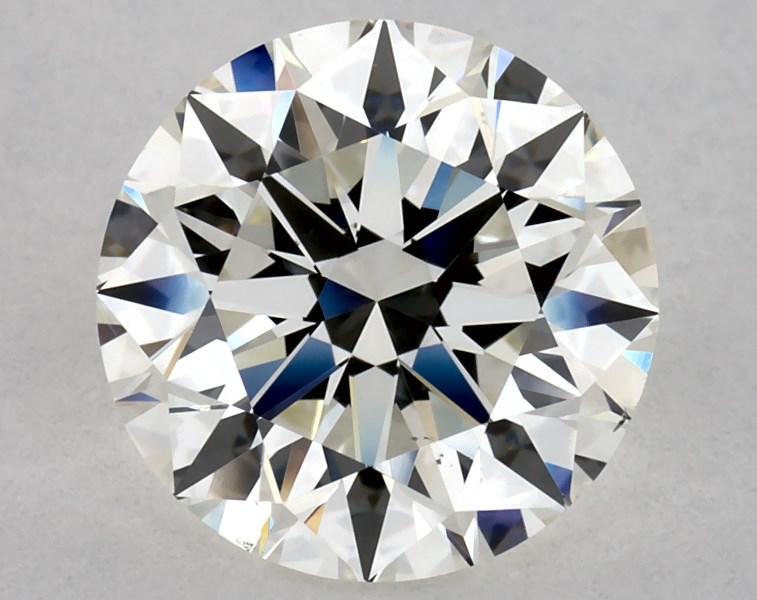

As a general rule, we don’t think it’s worth overpaying for diamond color. This means that there aren’t very many situations in which we’d recommend buying an E color diamond over one with a lower color grade.
If you’re absolutely set on buying a diamond that’s as close to colorless as possible, buying an E color diamond (or even a D color diamond) will definitely get you a highly white, transparent diamond.
However, this just isn’t necessary — at this point, color is an expensive feature you likely won’t ever notice in real life.
Instead, a better approach is to buy a diamond with the lowest color grade that will still appear colorless in relation to its setting. We’ve listed our recommendations for this below, with options for a variety of diamond shapes and setting types.
For round diamonds, spending extra for an E color diamond just isn’t necessary. The round cut does a great job of concealing a diamond’s color, meaning diamonds of lower color grades look virtually identical to those in the D, E and F range.
For white metals such as white gold or platinum, we recommend choosing a round diamond in the H to J color range. The I color round diamond from James Allen we mentioned earlier is a fantastic choice for any white metal, offering a colorless appearance at a lower price than an E color diamond.
For colored metals like yellow or rose gold, you can drop down to the J to K range. While any diamond in this range will look slightly yellow, even to the naked eye, the color of the gold will make any diamond look slightly colored anyway, meaning this is a non-issue.
While there’s nothing wrong with buying an E color fancy shape diamond, doing so isn’t a good idea if your goal is to achieve the optimal combination of aesthetics and value for money.
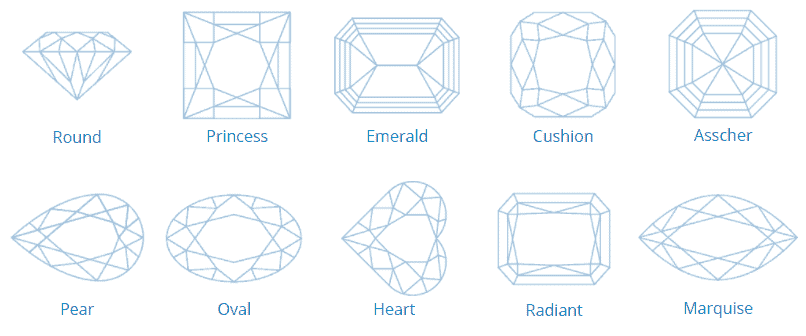
For Asscher, emerald and princess cut diamonds set in white metals, we typically recommend choosing something in the G to I color range. These diamond cuts all conceal color quite well, meaning a diamond from this range will appear colorless in its setting.
For the above diamond shapes in a yellow or rose gold setting, it’s alright to go down to the J to K range without the diamond appearing overly yellow in relation to its setting.
For all other diamond shapes, we recommend the F to H color grades for white gold or platinum rings, or the I to J color grades for yellow or rose gold settings.
For buying any diamond, it’s important to shop with a reputable vendor, one you can be confident is not going to rip you off by convincing you to overpay for a poor-quality diamond.
This is even more important if you’re in the market for an E color diamond, as the price difference, coupled with a negligible difference to the naked eye, means it’s easy to be duped into paying an E diamond price for a diamond that’s really several grades lower.
We recommend James Allen or Blue Nile for any diamond purchase. These two retailers carry a huge range of GIA-certified diamonds, meaning you can be confident the diamond you’re getting comes with a fair and accurate grade.
Both James Allen and Blue Nile also provide shoppers with excellent diamond inspection tools, such as high-quality, 360° images, to help you inspect every part of a diamond before committing to a decision.
There is no doubt that E color diamonds are beautiful, but they may not be the best choice for value. A beautiful H color diamond will often look better than an E color diamond like this from Blue Nile where you are sacrificing on brilliance.
We’ve covered below whether or not it’s a good idea to buy an E color diamond, as well as the basics of what E color diamonds are and how they fit into the diamond color scale. We’ve also compared several E color diamonds to a range of diamonds in other color grades to give you an idea of how they look in person.
E is the better color grade between E and F color diamonds. It’s only one level below the highest color grade on the diamond color scale, though it’s virtually impossible to tell the difference between the two under normal viewing conditions.
D color diamonds are “better” when judged by objective quality. D is higher on the diamond color scale, as the highest color grade there is. E color diamonds, however, would make a better purchase, as they’re cheaper than D color, yet appear no less beautiful to the naked eye.
While E color diamonds can look extremely colorless and beautiful, the differences between an E color diamond and a diamond with a G or H color grade are almost impossible to identify with the naked eye and generally aren’t worth the extra money.
This is also true for D and F diamonds, which look undeniably beautiful but command a massive price premium compared to diamonds in the G to J range.
As we mention in our guide to diamond color, a diamond’s color shouldn’t take a front seat in your diamond purchasing decision. Instead, pick a diamond with the highest cut quality, then choose a color grade that ensures it looks colorless in relation to its setting.
If you need more help, feel free to contact us. We can help you find the highest quality diamond for your budget and tastes.
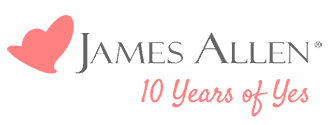



Before you buy a diamond, get personal buying advice from industry veterans. We'll help you get the best diamond for the money.
DISCLAIMER: We don't use your email for marketing. Period.
A diamonds’ price is determined primarily by the 4 Cs of the diamond. On the wholesale level, diamond prices are first based on a diamond shape and
Buying an engagement ring is often one of the first major purchases in a person's life. The process can be fraught with tension as there are so m
A wide range of 1 carat diamonds exist both in online markets and local diamond jewelry stores. Not only are there significant differences in beauty
Please enter your email address to receive your 25% off coupon code:
Here is your coupon code: GFDSF3GF